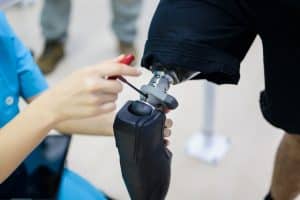If you’re a veteran dealing with elbow pain and preparing for a Compensation and Pension (C&P) exam, it’s natural to feel anxious about what lies ahead. This guide is designed to demystify the process of the C&P exam for elbow pain and help you understand what to expect during the examination, particularly if your elbow condition is service-connected.
Whether your condition is directly related to your military service or a secondary condition that has developed over time, Leah will walk you through the examination process, the types of questions you might face, and what the examiner is likely to focus on during your visit.
Table of Contents
Understanding C&P Exam for Elbow Pain
C&P exams are critical evaluations used by the Department of Veterans Affairs (VA) to determine the extent of a veteran’s disability and its connection to their service. These exams are particularly nerve-wracking, given their importance in establishing eligibility for disability benefits. However, understanding what happens during the exam can help alleviate some of the anxiety.
Direct and Secondary Service Connections
Veterans can be service-connected for a variety of elbow conditions, either directly or secondarily. A direct service connection occurs when the elbow condition developed during active duty and has persisted over time. Common examples include injuries sustained in accidents, fractures, or overuse injuries from repetitive tasks such as those performed by mechanics or other physically demanding roles.
Secondary service connections arise when an elbow condition develops as a result of a different service-connected condition. For instance, if a veteran is service-connected for a right elbow condition and begins to overuse their left elbow to compensate, the left elbow condition could potentially be considered a secondary service connection.
Preparing for the C&P Exam for Elbow Pain
Prior to your C&P exam, you should receive a packet detailing where and when the exam will take place, who will be conducting it, and what the examination will cover. The examiner could be a physician, a nurse practitioner, or a physician assistant. While it may not always be an orthopedic specialist, any qualified medical professional can conduct the evaluation as it involves assessing physical function rather than performing complex procedures.
It’s a good idea to familiarize yourself with the Disability Benefits Questionnaire (DBQ) specific to elbow conditions, which can be found on the VA’s website. This document outlines the various aspects of the examination, and you can even take it to your treating doctor if you want them to fill it out.
What Happens During the C&P Exam?
Initial Documentation and Medical History
The first part of the exam involves documenting your personal information and medical history. This includes your name, Social Security number, the date of the examination, and details about your medical background. The examiner will ask about your dominant hand (right, left, or ambidextrous) as this can influence your condition and its severity.
You’ll also be asked about the onset of your elbow condition. This is your opportunity to explain how your elbow issues began, whether due to an incident during your service or as a result of repetitive tasks. The examiner will document any diagnoses related to your elbow pain, such as triceps tendonitis, lateral epicondylitis (tennis elbow), or medial epicondylitis (golfer’s elbow). If you have multiple conditions, each will be listed along with their respective diagnosis codes.
Assessing Pain and Functional Impact
One of the key parts of the exam involves discussing and documenting the pain and functional limitations associated with your elbow condition. The examiner will ask if you experience flare-ups—periods when your symptoms become more severe. You’ll need to describe the frequency, duration, and severity of these flare-ups, along with any factors that worsen or alleviate your pain.
The exam will also cover any functional loss or impairment caused by your elbow condition. For instance, you may be asked if you experience pain during certain movements, such as flexion (bending the elbow), extension (straightening the elbow), supination (rotating the forearm outward), or pronation (rotating the forearm inward).
Range of Motion Testing
Range of motion (ROM) is a critical aspect of the C&P exam for elbow conditions. The examiner will test both active and passive ROM. Active ROM involves you moving your elbow on your own, while passive ROM is assessed by the examiner moving your elbow for you. This is done to determine the extent of your functional loss, if any.
The examiner will measure the range of motion for both the affected and unaffected elbows. These measurements are crucial for understanding the severity of your condition. If your ROM is abnormal, the examiner will try to determine whether this abnormality contributes to your functional loss.
Evaluating Pain During Movement
The C&P exam also involves assessing pain during both weight-bearing and non-weight-bearing movements. This part of the exam is designed to understand how your elbow condition affects your daily activities and overall quality of life. For example, the examiner may ask if you experience pain when carrying objects or if your pain worsens during repetitive use.
Additional Factors Contributing to Disability
The examiner will look for other factors that might contribute to your disability, such as muscle atrophy, weakness, or lack of endurance. They may measure the circumference of your arms to detect any muscle atrophy, which could indicate that the affected arm has been used less frequently due to pain or limited functionality.
Surgical History and Scarring
If you’ve undergone any surgical procedures related to your elbow condition, these will also be discussed. The examiner will note whether you’ve had a total elbow joint replacement, arthroscopic surgery, or other procedures, and will document any residual effects such as weakness or limited motion.
If you have scars from surgeries or injuries, the examiner will note their size, location, and whether they contribute to your disability. Scars can sometimes be rated separately for disability compensation.
Use of Assistive Devices
The C&P exam may include questions about whether you use any assistive devices, such as a brace, to help manage your elbow condition. The examiner will document the type of device you use and how often you rely on it.
Functional Impact on Daily Life
One of the final parts of the exam involves assessing how your elbow condition impacts your ability to perform daily tasks and occupational duties. This is a crucial component, as it directly influences the VA’s decision regarding your disability rating. Be prepared to discuss any limitations you face at work, during hobbies, or in performing basic daily activities.
Diagnostic Testing and Final Evaluation
The examiner may review any diagnostic tests you’ve undergone, such as X-rays, MRIs, or CT scans. These tests help to provide a clearer picture of your elbow condition, particularly if you have conditions like post-traumatic arthritis.
At the end of the exam, the examiner will summarize their findings and provide an estimate of your functional capabilities. This summary plays a key role in determining your disability rating and, ultimately, your eligibility for compensation.
Certification and Final Steps
After the exam, the examiner will complete the necessary paperwork, certify the findings, and submit the report to the VA. You won’t receive your results immediately, but you can request a copy of the exam report through your VA healthcare provider or online portal.
Conclusion
A C&P exam for elbow pain is a comprehensive evaluation that covers a wide range of factors, from your medical history and current symptoms to the functional impact of your condition on daily life. By understanding the process and what to expect, you can approach your exam with greater confidence and clarity. Remember to be honest and thorough in your responses, as this information is crucial for accurately assessing your condition and securing the benefits you deserve.
Also read: Depression Secondary to Back Pain in Veterans Disability
At Prestige Veteran Medical Consulting, a veteran-owned company, we specialize in Independent Medical Opinions (IMOs) known as Nexus letters.
Our purpose is to empower YOU, the veteran, to take charge of your medical evidence and provide you with valuable educational tools and research to guide you on your journey.
Understanding the unique challenges veterans face, our commitment lies in delivering exceptional service and support.
Leveraging an extensive network of licensed independent medical professionals, all well-versed in the medical professional aspects of the VA claims process, we review the necessary medical evidence to incorporate in our reports related to your VA Disability Claim.
Prestige Veteran Medical Consulting is not a law firm, accredited claims agent, or affiliated with the Veterans Administration or Veterans Services Organizations. However, we are happy to discuss your case with your accredited VA legal professional.














